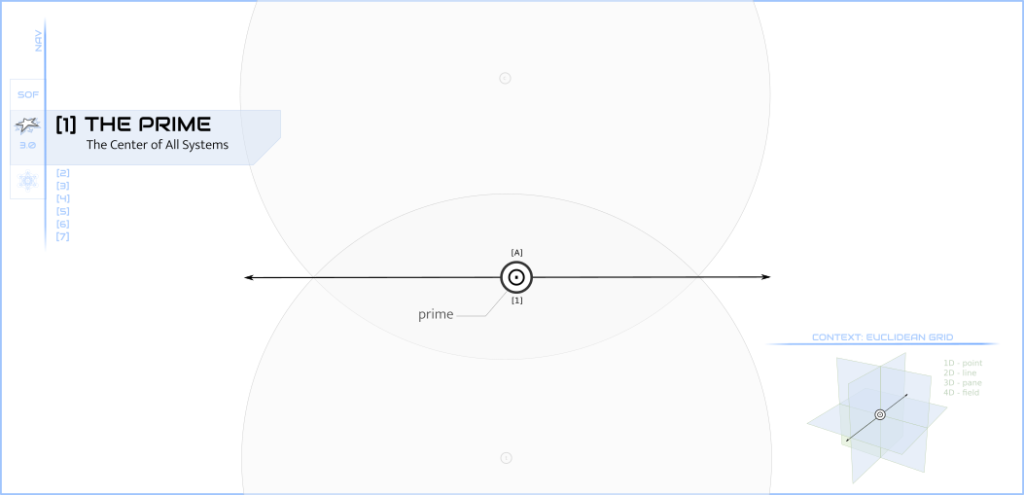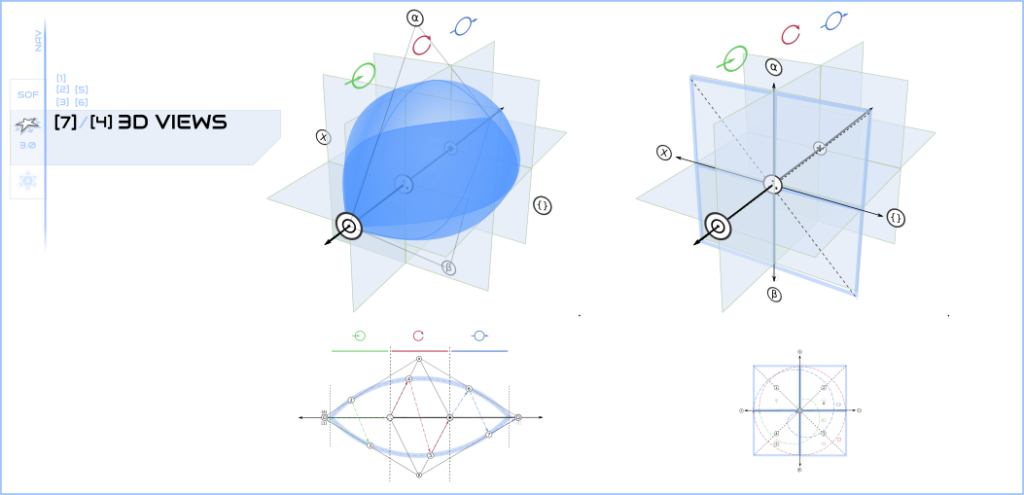
[1] The Prime
The Prime is the central purpose and power of a system. All systems have a central purpose which is the center of gravity holding the system together. The Prime also contributes to organizing the components of the system through sourcing (unity of motion). Additionally, the Prime propels the systems towards the fulfillment of its purpose with its energy1 — this is the Prime. The Prime is a Frame illustrating the first systems shape of Semantic Ontology Framework (SOF).
Origin
The universe has a conceptually linear component: it originates from a single point in space and time and proceeds in a direction towards and end. The origin point is called variously Creation or The Big Bang, and whether the origin story is mythic or scientific, it has a deterministic effect on all actions and interactions since (Will of God, Law of Causality, First Law of Thermodynamics). All systems, as sub-systems of the Universe — share this basic linear nature in that the arise from and origin point of a starting state and that origin point as a deterministic power over the character and evolution of the system and its motion. The idea of Prime combines origin point, the deterministic power of the origin, and the central role that origin has on the evolution of the system and its effects.
The Prime can be thought of geometrically as (see Symbology below):
- A point in one-dimensional representations of systems
- A line in two-dimensional representations of systems2
- An intersection of planes and fields in three dimensional space.
Prime as Unity
All events and objects in the Universe share in common the origin point, even though they diversify greatly from that point. That means the origin is the first and most universal unity of the Universe, and by analogy, all systems. This can be seen in many of the unifying principles of systems:
- Holarchy: Something is always single, always a set, and always part of a set.
- Unity of Science: Science is united by one set of fundamental laws which all disciplines draw from and contribute to.
- Shema Yisrael: Hear, Israel: Yahweh is our God. Yahweh is one. You shall love Yahweh your God with all your heart, with all your soul, and with all your might. (Deuteronomy 6:4-5 WEB)
- Convergere Omnia: In him [Jesus Christ] we have redemption through his blood, the forgiveness of our trespasses, according to the riches of his grace, which he lavished upon us, in all wisdom and insight making known to us the mystery of his will, according to his purpose, which he set forth in Christ as a plan for the fullness of time, to unite all things in him, things in heaven and things on earth. (Ephesians 1:7-10)
- Unity in the Body: There is one body and one Spirit—just as you were called to the one hope that belongs to your call— one Lord, one faith, one baptism, one God and Father of all, who is over all and through all and in all. (Ephesians 4:4-6)
Rule One
The Prime is governed by Rule One of systems thinking, also known as the Law of Primes.
Systems should be understood and managed from the greatest purpose and highest unity possible.
Rules by Implication
Centered over Bounded Sets: In most cases, one should only focus temporarily on bounded sets: groups of things defined by a limit (a bound) because these bounds are either inherently arbitrary or of secondary importance to relativity and systemic relationships. Instead, one should focus primarily on centered sets: groups defined by their orientation to a Prime or center which creates and nurtures their relationship to each other. While centers in the centered set take more energy to discern and monitor then bounds, they offer more holistic power, fidelity, and integrity in interactions (participation) and interventions (leadership).
People over Systems: Agents are by definition are deterministic, meaning that by taking action within a system, they describe, define, and create purpose within a system. This means that people and purpose have a special connection — indeed, any purpose requires a referential Person to be associated with it. This means interaction or intervention in systems that involve people should always focus on elevating, or more precisely, facilitating the emergence of, the identity and power of people. This is the first rule of [4] The Four Rules of the Hacker Ethic.
Find Big Prime (At Least Three Whys): Since all systems are subject to Holarchy, interactions and interventions in systems must always keep in view a Prime much bigger than the immediate or mechanistic purpose of evident in the system itself. Any system managed by a small Prime will suffer from insufficient gravity leading to disintegration, low gravity and energy leading to unsustainability, and/or low energy that will effect the efficacy and durability of its products. As a quick and general rule of thumb, participants or leaders in a system should ask why three times in succession, each gaining broader scope, to gain a Prime big enough for good systems function: a thinking tool called At Least Three Whys.
Problems
There a various systems problems associated with the Prime:
- The Invisibility of Primes: the central purpose of a system (the Prime) is not always apparent, especially at the beginning of encounter or evolution of the system. However, if the Prime remains invisible, especially to those with agency, other non-central purposes will destabilize, misdirect, or co-opt the system. Primes can be found using the [3] David’s Bow frame and its derivatives or through thought disciplines like At Least Three Whys.
The High Primes
While any Prime in a system can be parsed by a variety of concepts and ideas which could be considered “central” to the system, there are certain prime concepts that can be considered “high primes” due to their universality and importance. Here are a few lists of “high primes” by discipline:
Symbology
The Prime is often illustrated using the Sol symbol (☉) since the Sun’s role in relation to the solar system and Earth systems effectively illustrates the role of the Prime in any system. The Sun is the source of gravity that holds the solar system together (in tension with angular momentum, thus creating orbits), and this also keeps the Earth in its proper place in the “Goldilocks Zone” where water is liquid and life is possible. The Sun also provides the energy for most Earth systems, either through its thermal contributions, or through the contribution of light energy to the photosynthetic process that supports most organic life (even eventually fossil fuels).
The dynamic role of the Prime is often symbolized in two-dimensional systems diagrams as a line, and in three dimensional representations as the intersection of planes or fields.

Examples
There is a prime tag in the Codex that can identify examples of primes in other entries, and a prime tag for posts that can identify examples of primes in other content.
Related Entries
References & Notes
- The role of Prime in a system relates strongly to the concept of glory (כָּבַד kaw-bode “weight”) in theology. Many civilizations developed the Sun as a metaphor or manifestation of the highest or only god. The Sun has two immediately apparent qualities: its great size and energy. This is a fitting analogy to two apparent qualities of the Divine: his immense spiritual mass and gravity, and his boundless energy.
- This line proceeds from the origin point in one direction in conceptual systems based on material reductionism and an infinite line is spiritual systems that entertain the concept of eternity.



